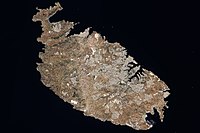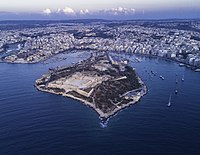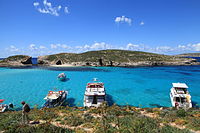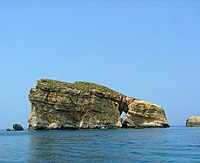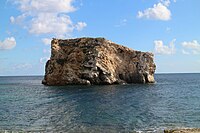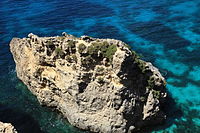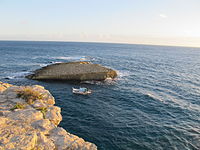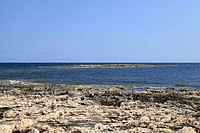
Geography of the Federated States of Micronesia (FSM), a country located in the western Pacific Ocean, and in the Micronesia cultural and ecological sub-region of Oceania. While its total land area is very small at 702 km2 (271 sq mi), it has the 14th largest exclusive economic zone at 2,996,419 km2 (1,156,924 sq mi).
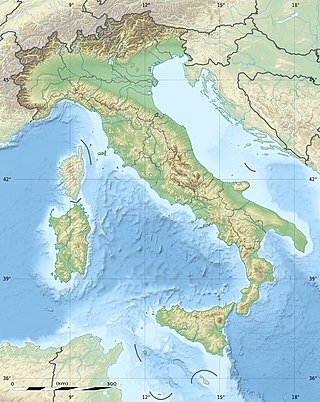
The geography of Italy includes the description of all the physical geographical elements of Italy. Italy, whose territory largely coincides with the homonymous geographical region, is located in southern Europe and comprises the long, boot-shaped Italian Peninsula crossed by the Apennines, the southern side of Alps, the large plain of the Po Valley and some islands including Sicily and Sardinia. Italy is part of the Northern Hemisphere. Two of the Pelagie Islands are located on the African continent.
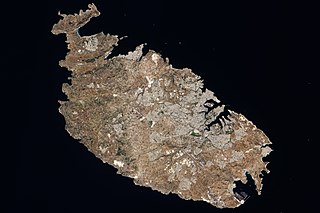
Malta is an island in Southern Europe. It is the largest and most populous of the three major islands that constitute the Maltese Archipelago.The island is situated in the Mediterranean Sea directly south of Italy and north of Libya. It lies south-east of the smaller islands of Gozo and Comino.The island is 27 kilometres (17 mi) long and 14.5 kilometres (9 mi) wide, with a total area of 246 square kilometres (95 sq mi). The capital is Valletta, while the largest locality is Rabat. The island is made up of many small towns, which together form one larger urban zone with a population of 409,259. The landscape is characterised by low hills with terraced fields.

Filfla is a mostly barren, uninhabited islet 4.5 kilometres south of Malta, and is the most southerly point of the Maltese Archipelago. Filflu, a rocky islet some 101 metres southwest of Filfla, has the southernmost point of Malta. The name is believed to come from felfel, the Arabic for a peppercorn.

Comino is a small island of the Maltese archipelago between the islands of Malta and Gozo in the Mediterranean Sea, measuring 3.5 square kilometres (1.4 sq mi) in area. Named after the cumin seed, the island has a permanent population of only two residents and is part of the municipality of Għajnsielem, in southeastern Gozo, from where one priest and one policeman commute. The island is a bird sanctuary and nature reserve.

Fungus Rock, sometimes known as Mushroom Rock, and among the Maltese as Il-Ġebla tal-Ġeneral, is a small islet in the form of a 60-metre-high (200 ft) massive lump of limestone at the entrance to an almost circular black lagoon in Dwejra, on the coast of Gozo, itself an island in the Maltese archipelago. It is located at 36°02′45″N14°11′27″E and falls within the jurisdiction of the town of San Lawrenz.
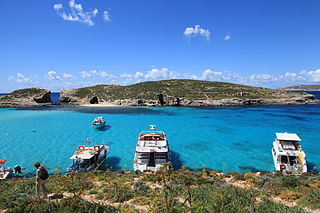
Cominotto, sometimes referred to as Cominetto, is an uninhabited Mediterranean island off the northern coast of the island of Gozo, Malta. It is located near the larger island of Comino and is part of the Maltese archipelago. Measuring 0.25 square kilometres (0.10 sq mi) in area, it is the largest uninhabited island of Malta. Cominotto lies about 100 metres to the north-west of Comino. The island has multiple tourist attractions.

Qala is an administrative unit of Malta, on the island of Gozo, with a population of 1,929 as of September 2019. Nearby is Ħondoq ir-Rummien, a coastline with salt pans and caves.

The Diocese of Gozo is a Latin diocese of the Catholic Church in Malta, and the only suffragan in the ecclesiastical province of the Metropolitan Archdiocese of Malta, together covering the insular state.

Malta is for non-local government purposes divided into districts as opposed to the local government localities. The three main types of such districts – statistical, electoral at national level, and policing – have no mainstream administrative effect as the local councils form the first-tier – moreover only administrative tier – divisions of the country.

The filfola lizard or Maltese wall lizard is a species of lizard in the family Lacertidae. It is found in Italy and in the island group of Malta. Its natural habitats are Mediterranean-type shrubby vegetation, rocky areas, rocky shores, arable land, pastureland, and rural gardens.

The following outline is provided as an overview of and topical guide to Malta:

Gozo Region is one of five regions of Malta. The region includes the islands of Gozo, Comino and several little islets such as Cominotto. The region does not border with any other regions, but it is close to the Northern Region.
The Malta–Gozo Channel Important Bird Area lies in the Maltese archipelago of the Mediterranean Sea. It encompasses some 123 km2 of the Gozo Channel, between the islands of Malta and Gozo, as well as the waters up to 7 km offshore from Rdum Tal-Madonna in Malta to the east and immediately offshore from Ta' Ċenċ Cliffs in Gozo to the west. It was identified as an Important Bird Area (IBA) by BirdLife International because it supports about 1300 breeding pairs of Cory's shearwaters and 600–1000 pairs of yelkouan shearwaters, as well as up to 1000 ferruginous ducks on passage during the migration season.

Ħalfa Rock(Maltese: Il-Ġebla tal-Ħalfaor Il-Blata tal-Ħalfa) is a deserted small islet and limestone rock on the south-east coast of the island of Gozo in the Maltese archipelago. The small islet is typified by a small maritime labiate garrigue environment, with germander and prasium shrubs, with the occurrence of the endemic Maltese Pyramidal Orchid as well as endemic coastal communities based on the Maltese Sea-Lavender and the sub-endemic Maltese Crosswort.

The Geology of Malta consists of a sequence of sedimentary rocks of late Oligocene to late Miocene age cut through by a set of extensional faults of Pliocene age.

The geographyof Gozo, is dominated by water as it is the second largest island in the Maltese archipelago and is made up out of limestone. There are several islands which fall under Gozitan jurisdiction and thus are additions to the overarching Maltese archipelago. The main island of Gozo is located 7 kilometres (4.3 mi) northwest of the main island of Malta. It is mostly known for its multitude of low-lying hills. The highest point in Gozo is Ta' Dbiegi hill, which falls under the San Lawrenz local council. The island of Comino, which is also the third largest island in Malta, falls under Gozo.



